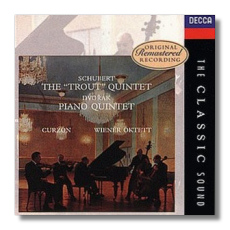
The Internet's Premier Classical Music Source
Related Links
- Latest Reviews
- More Reviews
-
By Composer
-
Collections
DVD & Blu-ray
Books
Concert Reviews
Articles/Interviews
Software
Audio
Search Amazon
Recommended Links
Site News
 CD Review
CD Review
Schubert / Dvořák

Piano Quintets
- Franz Schubert: Piano Quintet in A Major "The Trout"
- Antonín Dvořák: Piano Quintet in A Major, Op. 81
Clifford Curzon, piano
Members of the Vienna Octet
Vienna Philharmonic String Quartet
London "The Classic Sound" 448602-2
Okay, I am ready to argue that this particular recording of these pieces is the best ever. This is true in the recording sense as well as the interpretation. I also have in my collection two other recordings. I will consider the recording of the Cleveland Quartet and John O'Connor (Telarc CD-80225, coupled with Schubert's Quartet #13).
The Curzon recording, in one sense, is not as good as the Telarc, but given the basic integration and warmth of sound, it is as good. (When I wrote that last locution only God and I knew what it meant. Now only She does.) As convoluted as that may sound it is the best way to tell you that this 1957 recording is detailed and warm, the ear appreciates the sound quickly. The Telarc is an aural bath, no argument there, but has its problems which I will get to momentarily.
The Curzon recording, to put it succinctly, is in a different league than the Telarc one. In fact, you might argue that the Telarc isn't even on the same continent. The latter is a tame, civilized "Trout" (one doesn't put live worms on the hook, does one?). The Curzon recording is more Viennese (for lack of a better word). From the outset Curzon's piano sets forth a flowing current not as clear in O'Connors' recording. Yet, in the fourth movement (at around 3:45) the clarity of the piano contributes to O'Connors' piano being absolutely a percussive instrument, robbing the piece of its inherent warmth. The whole thing has to do with the sense of relief in the Decca recording. In the Telarc the piano is more integrated within the texture of the other instruments at the outset. Then it seems to jump out at you as if someone in the control booth suddenly twisted the recording level knob over a particular instrument. Curzon's piano is an equal partner and is integrated with the other instruments throughout the recording.
The Dvořák Quintet is no less appealing. Recorded in 1962, it does sound just a little better than the Schubert. Here, again, Curzon's piano work, the interplay between the right and left hand, constantly skips along, taking me with it. The recording detail here, again, places the piano as an equal partner. I am not going to compare this with my other recordings, there's no sense in wasting words.
So, if you can find this (it may be found in cities important enough to warrant Tower Records' interest as a special import) don't hesitate. These recordings, so coupled, are the bargain of 1996.
Copyright © 1995, Robert Stumpf II


















